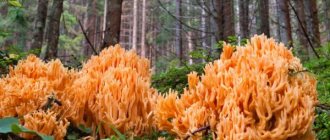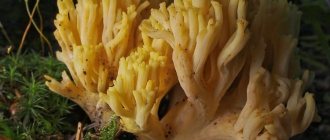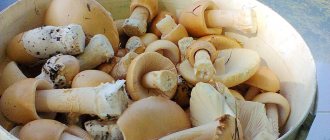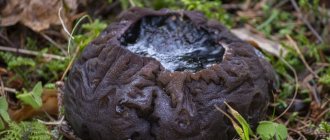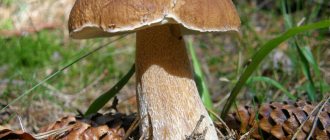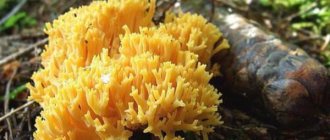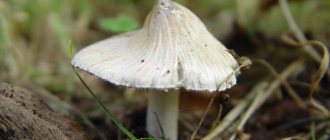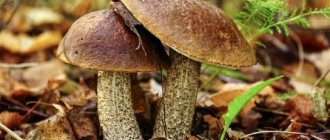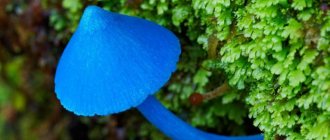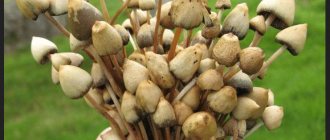The mushroom belongs to the category of edible species, has excellent taste, it can be salted, pickled, fried, etc. Find out how and where you can find amazing fruits in the forest, how to correctly identify them and what delicious things to cook from horned mushrooms.
Systematics, characteristics and description of the structure
Rogatik yellow belongs to the species Ramaria yellow, genus Ramaria, family Gomphova. Other names: Yellow Ramaria, Yellow Rogatik, Bear's Paw, Yellow Coral. The name in Latin is Ramaria flava.
The height of the slingshot sometimes reaches 20 cm. The diameter can be the same. The fruiting body is highly branched and consists of fleshy, sulfur-yellow or lemon-yellow branches. Later they change color to ocher or orange. The tips of the branches are blunt, with irregularly truncated ends.
Reference! If you press on the fruiting body of the hornet, a wine-brown spot will form at this place.
The pulp is fragile and has a watery consistency. Its color is light, yellowish, its smell is weak, pleasant, floury, its taste is inexpressive. As the fruiting body ages, it becomes bitter, especially in the branches.
The leg reaches 8 cm in length and 5 cm in thickness. It is painted in all shades of yellow depending on the color of the entire fruit, becoming lighter closer to the base. If pressed, it turns reddish-brown.
The spore powder is white; the spores themselves are formed on the outer surface of the mushroom.
A little history
This species was first described by the scientist Joseph de Tournefort, a French botanist, in 1755. Ramaria yellow received its binomial name thanks to Lucien Quele, the founder of the French Mycological Society, in 1888.
Golden ramaria (golden hornet)
to contents
| based on the book by Kovalenko E.I., N.N., A.E. “Edible and poisonous mushrooms of Kuban” | Ramarla aurea (Fr.) Quel. The fruiting body is highly branched, massive, 5-15 (20) cm high, 8-20 cm wide. The branches are densely located, thick, short. The tips of the branches are light in color when young. The color of the fruit body is pale yellow, golden yellow or yellowish-brown, then dark ocher. The stalk is 1-5 cm in diameter, 2-4 cm in height, usually tuberous, the base is whitish. The pulp is white, yellowish under the surface, watery, brittle. Spores are 8-15X3-6 microns, oblong, yellowish-brown, rough or almost smooth, with one or several drops of oil. Foothill belt (surrounding the villages of Kaluzhskaya and Smolenskaya), in deciduous and coniferous forests, on the soil. June—October. Soil temperature 21 - 12. Rarely, few. Edible, category IV, fresh. |
to contents
| based on the book by Kovalenko E.I., N.N., A.E. “Edible and poisonous mushrooms of Kuban” | Boletus edulis Fr. The cap is 8-20(25) cm in diameter, 2-6 cm thick, hemispherical, convex, cushion-shaped and sometimes flat when aging, dark brown, brown, light brown, yellowish-brown to off-white with lighter spots. The edge is straight, solid, smooth, thick. The surface is smooth, thin-felt, sometimes wrinkled, dry, matte. The skin does not separate from the pulp. The pulp is 1.3-4 cm thick, fleshy, dense, looser with aging, white, does not change with aging and breaking. The taste is fresh, the smell is pleasant. The tubes are 0.7–2 cm long, white. The pores are small, round, white, then yellowish to yellowish-greenish, so the lower surface of the cap also turns yellow and becomes yellowish-greenish in old age. Leg 8-12X3.5-5 (7) cm, tuberous, tuberous thickened towards the base, sometimes almost cylindrical, straight or slightly curved, solid, dry, matte, whitish or light brown with a white mesh pattern in the upper part of the leg, and sometimes over the entire surface of the leg. Spores are 11-17X4-5 µm, fusiform, smooth, yellowish-brownish. Everywhere (the vicinity of the villages of Smolenskaya, Saratovskaya, Stavropolskaya, Kaluga, Goryachiy Klyuch), in oak, hornbeam-oak, pine, fir-beech, beech-fir forests, in clearings, in bushes, on clay, sandy loam soil. May—September. Soil temperature 17-20-6°. Infrequently, few, singly and in groups, in some years in some places a lot. |
Page 3
to contents
| based on the book by Kovalenko E.I., N.N., A.E. “Edible and poisonous mushrooms of Kuban” | Armillariella mellea (Fr.) Karst. The cap is 5-10 cm, hemispherical, convex, flat-convex, prostrate, often with a tubercle, gray-yellowish, dirty brown, darker towards the middle. The edge is bent down, then straight, even, solid, thin. The surface is dry, wet in wet weather, covered with thin brown, dark brown scales. The pulp is thin, fleshy, unbreakable, white. The taste is sourish-astringent, the smell is pleasant. The plates are frequent, briefly descending, white, then brownish-yellow, with darker spots, often with a white coating of spores, the edge is entire. Leg 5-15X1-1.5 cm, almost always curved, central, cylindrical, slightly thickened downwards (grows in a bunch, sometimes singly), solid, almost the same color with a cap, paler at the top, yellowish-brown at the bottom. Above the ring it is grooved, below it is fibrous and elastic. A private bedspread in the form of a membranous whitish ring. Spores 7 9 X 5—6 microns, ellilloid-ovoid, colorless, smooth, white in bulk. Foothill and mountain belts (south of the villages of Kaluga, Smolenskaya, Krepostnaya, the village of Ilsky, the vicinity of Kamyshanova Polyana, Psebay, Arkhyz, the right bank of the Laba), in forests, glades, clearings, forest roads, on stumps, at the base of trunks, on living trunks and roots of various species, on buried wood. June—November. Air temperature 18-21-5°. Very often, in places abundantly, usually in groups, sometimes singly, often in large “clusters”. Edible, category III, fresh, dried, pickled, salted. |
Page 4
to contents
| based on the book by Kovalenko E.I., N.N., A.E. “Edible and poisonous mushrooms of Kuban” | Amanita phalloides (Fr.) Quel. The cap is 5-10 (15) cm in diameter, 1.2-1.5 cm thick, hemispherical, then flat-convex, pale greenish to whitish, lighter at the edge, greenish-brown in the middle, color does not change when pressed. The edge is straight, entire, even, smooth or slightly ribbed. The surface is wet, then dry, silky, shiny, without flakes, sometimes 1-2 of them (remnants of the bedspread). The skin is very thin, completely separated from the pulp. The pulp is thin, 0.4-0.7 cm, fleshy, brittle, white, under the cuticle (skin) pale greenish-yellowish, does not change when broken. Slightly sweetish, mushroom smell, sharp. The plates are basic and intermediate, infrequent (8-10 pieces per 1 cm), free, fused at a young age, convex, wide - 0.7-1 cm, white, entire edge. Leg 8-12X1.2-2 cm, straight, central, cylindrical, gradually narrowed upward, tuberously swollen at the base, hollow, smooth, dry, bare or with pressed flaky small scales, white above the ring, below with dirty brownish-greenish zigzag stripes. When pressed, the color does not change. The general spathe (volva) is sac-like, lobed, non-adherent, white or greenish. Private bedspread in the form of a ribbed hanging ring. Its outer (lower) surface is white, its inner (upper) greenish-yellowish. Spores 8-10X7-8 microns, broadly ellipsoidal, ovoid, colorless, smooth, with one or two drops of oil. Foothill and mountain belts (the vicinity of Goryachiy Klyuch, the villages of Smolenskaya, Kaluga, Krepostnaya, Krasnaya Polyana and Lake Kardyvach, Engelmanova Polyana), in deciduous forests (oak, hornbeam, hazel, maple and others), on the edges, on different soils. June—December. Soil temperature 20-22-5° (before frost). Quite often, alone and in groups, sometimes a lot. Deadly poisonous. Poisons are not destroyed by any treatment. |
Source: https://BudetInteresno.info/gribochki/10.htm
Time and place of fruiting
The bear's paw prefers temperate climates. Settles on the soil in coniferous, deciduous and mixed forests. Grows singly or in small groups. Yellow horned grass can be found in the Caucasus mountains, Karelia, and Central European countries (Russia, Crimea, Belarus).
Fruiting time is August - September. It is listed in the Red Book as a rare species and is considered the highest mushroom.
Important! An older specimen of yellow ramaria begins to taste bitter, so experienced lovers of quiet hunting recommend collecting slingshots at a young age, i.e. in early August-September.
Video
Answers to common questions
Mushrooms of normal shape raise a lot of questions among mushroom pickers:
When collecting any mushrooms, certain rules must be strictly observed: the crop is cut and not ripped off by the roots; The soil and moss in the forest should not be stirred up or dug up too much; picking mushrooms in nature reserves is prohibited; mass collection of any species will certainly lead to its extinction.
The rubbery pulp of kalocera has a reddish tint. The false mushroom has no taste or smell. The fruiting body has pointed branches and is dark yellow or orange. Real yellow corals are very similar to Kalocera, which are not characterized by the cartilaginous and gelatinous consistency of the fruiting body.
The coral hedgehog is one of the most unusual representatives of its family. It is famous not only for its interesting shape, but also for its good taste. But when collecting this species, you should be extremely careful, because it can easily be confused with false corals.
| Name: | Deer horns |
| Type: | Edible |
You need to cook reindeer horn mushrooms correctly. The main condition is the use of young specimens. The product can be salted, fried, dried. The taste of horned mushrooms is similar to chicken or shrimp. The pulp is tender. The official name is Ramaria yellow. Grows in deciduous and mixed forests. The best time to collect is the end of August or the beginning of September.
False doubles
Bear's claw can be confused with similar species that are not always edible. Therefore, it makes sense to carefully study the features of the mushroom in the photo and look at the table so as not to confuse dangerous species with the harmless horned mushroom:
| Name | Differences | Edibility |
| Blunt Horntail Ramaria obtusissima | It has rounded ends of the branches and is quite bitter in taste. Found in Siberia, in mixed forests, with the presence of fir, in Far Eastern oak plantings. | Inedible |
| Yellow-brown hornet Ramaria flavobrunnescens | The height of the fruiting body does not exceed 10 cm; as they mature, dark brown spots appear on the mushrooms. | Conditionally edible |
| Golden Hornbill Ramaria aurea | It is painted in a brighter ocher-yellow color, becoming lighter closer to the base. | Conditionally edible |
| Golden-yellow horntail | A smaller fruiting body (up to 15 cm in height) is found only in the Primorsky Territory. | Conditionally edible |
| Kalocera sticky Ramaria lutea | Grows on stumps and dead wood. It has a bright egg-yellow color, dense jelly-like pulp | Yadovita |
Reference! The word flava in the name of the mushroom means “yellow”.
Kinds
These organisms are divided into edible and inedible. There are no cattails that are dangerous to human life and health. For a mushroom picker, edible horned mushrooms are a real find if you know how to prepare them correctly. These mushrooms are relatives of chanterelles.
Edible species include:
- golden;
- amethyst;
- grape-shaped;
- yellow;
- truncated;
- reed.
Inedible species:
- fusiform;
- comb;
- pale yellow;
- purple;
- pistillate
- piped;
- straight.
Edible young horned mushrooms are mushrooms with a pleasant aroma and are easy to prepare. Most often they produce a large harvest.
Rogatik reed
Hornweed (Clavariadelphus ligula) is an edible species with a pale yellow tint. It belongs to the saprophytes of the 4th category of edibility.
Its branches are cylindrical, thin, widened at the bottom. The appearance resembles a human tongue sticking out of the ground, hence the name. The reed hornet grows in coniferous forests in whole groups in the shape of circles, which foresters call witch circles.
Their size is small, up to 10 cm in height. Collection begins in late summer.
Ramaria
Forest corals are the name given to ramaria, which grows in pine forests. Its trunk is incredibly beautiful and looks like a branched marine organism that accidentally fell into the forest thicket. The appearance of ramaria is characterized by:
- dichotomous stem;
- white color of the inner layer;
- hymenial surface (having spores);
- yellow.
With age, ramaria changes color to orange-red. It is believed that fox and horned species have common ancestors, so they have a certain similarity in structure.
Ramaria forms mycosis with spruce and pine. It can be eaten, but it has a bitter taste, so it should be collected at the end of August and September, because young ramaria is less bitter.
The horn is beautiful
This is a poisonous mushroom that grows in deciduous and mixed forests. It is characterized by:
- height - 20 cm;
- diameter - 18-20 cm;
- short, thick and dense leg;
- bright pink color in young organisms.
Old ramaria become whitish, branch strongly at the bottom, the tips of the branches first turn yellow, and then brown or brown.
Eating it leads to disruption of the gastrointestinal tract.
Crested Horntail
An inedible forest organism that bears fruit in conifers, deciduous and mixed forests from the second half of July until the end of October. Grows in groups of bushes. It has a comb shape and a cream or white body color, at the base of which is a thick, dense stalk.
The pulp has a characteristic bitterness. It is fragile and delicate, without a strong aroma.
Medicinal properties and use of mushroom in medicine
Ramaria yellow contains beneficial amino acids methionine and tryptophan, lipids, phytoagglutinin and sterol. The latter is often used by Chinese healers to heal problems with the gastrointestinal tract, as well as to improve lung function.
It is believed that yellow hornet also has antitumor properties and strengthens the immune system. In addition, deer horn mushroom is used in cosmetology to slow down the aging process and with skin aging.
In folk medicine, bear's paw is used to make infusions to treat joints and healing decoctions to get rid of helminths and parasites.
Application
Deer horns have a lot of useful properties due to their chemical composition.
Application in medicine
From their micellar structure they have learned to isolate polysaccharides that have the property of stopping Ehrlich carcinoma. It has been scientifically proven that blackberry extract successfully fights sarcoma.
These organisms are natural antibiotics and contain the precursor serotonin and hydrox tryptophan. For medicinal alcohol tinctures, they are collected young, until the bodies acquire a dark brown tint.
Use in cooking
A yellow mushroom is added to soups, and the reed mushroom is better suited for pates or caviar. Forest corals are used to make delicious snacks and pie fillings. Reed or yellow are great for frying in batter.
For preparations for the winter, drying or freezing, they are first well soaked and washed several times so that all the bitterness comes out and only a pleasant aroma remains.
Harm and contraindications
You should only collect familiar mushrooms; you must carefully sort through the harvest to prevent the ingress of poisonous individuals. Otherwise, severe poisoning occurs.
These unique and beautiful horns absorb all toxins from the environment, so there is no need to collect them near roads or near factories. Even edible species in this case can have a negative effect on the gastrointestinal tract.
Pregnant women should consult a gynecologist before consuming this forest delicacy. Children under 14 years old can only introduce it into their diet after consultation with a pediatrician.
Evaluation of taste, chemical composition, benefits and possible harm
Despite the fact that deer horns are classified as a fourth category mushroom due to the presence of a characteristic bitterness during the growth process, when young they are quite tasty and can be prepared in the same way as most other edible species.
Chemical composition per 100 grams of mushroom:
- 2 g protein;
- about 4.5 g fat;
- almost 3 g of carbohydrates.
Average caloric content is 55 kcal per 100 g.
The benefits of yellow ramaria include the following qualities:
- Prevention of the appearance of malignant neoplasms.
- Relieving depression and normalizing mental state.
- Strengthening blood vessels, stabilizing the functioning of the cardiovascular system.
- Getting rid of diseases of the bronchopulmonary system and respiratory organs.
- Prevention of thrombosis, normalization of blood pressure.
- Boosting immunity.
- Cleansing the body, removing toxins and breakdown products.
The main area of application of yellow corals in cosmetology is anti-aging procedures.
Deer horns have the ability to retain moisture in the epithelial layers; their effectiveness is several times greater than the properties of glycerin and hyaluronic acid. The natural polysaccharides contained in the chemical composition act as conductors of beneficial substances to the deep layers of the skin, and vitamin D activates metabolic processes.
Possible harm from consumption is also present. Like any other type of mushroom, yellow hornets are prohibited from being eaten by children under 12 years of age, pregnant and lactating women, people with chronic diseases of the gastrointestinal tract and a tendency to allergic manifestations.
What are the enemies of the common magpie?
Although the common magpie itself poses a threat to many representatives of the fauna, it also has enemies. In this list:
- owl;
- hawk;
- kite;
- eagle;
- eagle;
- falcon;
- owl;
- wild cat;
- marten.
Like many other birds, the common magpie has many natural enemies.
We suggest you read: Is it possible to give mustard grass to rabbits?
Among them:
- eagles;
- eagles;
- falcons;
- hawks;
- eagle owls;
- wild cats;
- owls;
The cultural significance of birds in different countries and nationalities differs greatly from each other. The Indians of North America associated the magpie with forest spirits, and in the regions of East Asia it was considered a harbinger of happiness and was treated with great honor. In European countries, the bird did not deserve special treatment from people.
Hunters did not tolerate the bird because of its characteristic behavior when detecting danger. If a hunter entered the forest, sitting in a nest or on a branch, she immediately uttered alarming cries and notified other animals about what was happening.
When poultry acquired high demand and new rates of development, the attitude towards poultry practically did not change. Until now, it is considered a harmful representative of birds, the corvid family, due to its ability to destroy the nests of small songbirds. But the harm caused to the flattering fauna is justified by the useful actions that the magpie does, destroying colonies of harmful insects.
Recipes for cooking dishes from reindeer horns
The widespread practical use of mushroom corals in cooking is due to their low calorie content and rapid digestibility. Nutritionists recommend dishes made from them to those who want to lose weight and improve their health at the same time.
The range of recipes and methods is extensive: yellow ramaria can be fried, boiled, pickled, pickled, cooked roast, fried with vegetables or potatoes, canned, cooked in salted form, cooked in soup, made in the form of caviar.
Primary treatment at home
To ensure the absence of bitterness, yellow ramaria is first boiled for 15–20 minutes, draining the broth or removing the ends of the branches. Forest “corals” processed in this way can be prepared like other edible mushrooms - boiled until fully cooked, fried and stewed, pickled and salted.
Interesting! True connoisseurs of mushrooms know that young deer horns are unique in dishes. Depending on the cooking method, they can resemble tender chicken breast or shrimp meat.
Cooking
- Reindeer antlers should be washed and soaked in a large volume of cold water for 1 hour.
- Then squeeze out the fruiting body and rinse again.
- Cut off the hard parts of the legs with a knife.
- Place the fruit in a pan of boiling salted water and cook for about 10-12 minutes.
- Drain the mushrooms in a colander after boiling and allow excess liquid to drain.
- Cut into thin strips or whatever the recipe calls for and continue cooking.
Pickling
Some lovers of quiet hunting are not very fond of pickled deer horns, and this is completely in vain. This beautiful mushroom in a jar resembles real coral. In winter, pickled yellow ramaria will come in very handy; it can decorate any table!
Ingredients:
- slingshots – 1 kg;
- salt – 1 tbsp. l.;
- sugar – 1 tbsp. l.;
- vinegar – 1 tsp;
- spices: cloves, bay leaves, peppers.
Step-by-step preparation:
- Carry out preliminary preparation: soak and boil the mushrooms for 10 minutes.
- Prepare the marinade in a deep container: dilute spices, seasonings, and vinegar in 1 liter of water.
- Place mushrooms in a saucepan and boil for 30 minutes.
- Place the pickled cattails in clean, sterilized jars and fill with boiling brine.
- Seal with plastic caps and store in a cool place.
Reference! Due to their structure, reindeer horns are considered one of the dirtiest mushrooms. They should be washed at least 3 times in running water.
Frying
Preparing fried yellow cattails is not at all difficult. This is done by analogy with the methods of cooking other mushrooms. At the end, add cream or sour cream, chopped herbs or garlic to taste - the dish will sparkle with new colors.
Ingredients:
- ramaria m 500 g;
- vegetable oil – 2 tbsp;
- salt - to taste;
- onion – 1 head;
- ground black pepper - a pinch.
How to cook reindeer horns mushrooms:
- Rinse thoroughly and pre-boil the fruiting bodies in salted water for 10 minutes.
- Squeeze lightly and strain out excess liquid.
- Peel the onion, chop into small cubes, fry in oil until soft.
- Cut the bear paws into strips or cubes. Place in the pan with the onions.
- Cook with the lid closed for 10–15 minutes, season with salt and spices.
Salting method
Fans of quiet hunting strongly do not recommend adding spices and aromatic herbs when salting yellow hornets, believing that this will only destroy the wonderful smell and taste of ramaria.
Components:
- salt – 40 g;
- mushrooms – 1 kg.
How to pickle bear paws:
- Before salting, you do not need to wash the fruiting bodies, otherwise they will become saturated with moisture and become soggy. Brush the ramaria gently with a brush to remove debris and leaves from the branches.
- Place the mushrooms in layers in a suitable container, sprinkling each with salt.
- Cover the bucket or pan with clean gauze and place a heavy weight on top.
- Store the workpiece in a cool place. After 30 days you can try the mushrooms.
Drying
Young fruits of yellow ramaria can be dried. Overripe fruiting bodies sometimes rot when dried, while young ones dry out easily.
To dry them, they need to be divided into the maximum possible number of branches, leaving part of the stem.
The thread will be threaded through it, and in addition, this way they will be secured more securely. Next, the mushroom garlands are hung in the shade in a dry and ventilated room.
Reference! When preparing dishes from dried deer horns, the mushroom must be soaked in water for 12 hours, then rinsed thoroughly and boiled for 10 minutes.
Ramaria soup
To prepare a delicious, rich soup, you don’t need to look for expensive ingredients; everything you need is always at hand. Serve a delicious first treat with black rye bread croutons.
Ingredients:
- slingshots – 400 g;
- onion – 1 head;
- carrots – 2 pcs.;
- potatoes - 3 tubers;
- butter – 30 g;
- garlic – 2 cloves;
- dill, salt - to taste.
Cooking process:
- Boil pre-soaked ramaria fruit bodies in salted water for 20 minutes. Drain the liquid and do not use again. Some housewives claim that you can boil the horned ones twice, it will only be better.
- Peel the vegetables and cut them into small cubes. Carrots, if desired, can be chopped using a grater.
- Place all the vegetables in a large container, add boiling water, cook for 10-15 minutes over medium heat.
- Add mushrooms, which can be pre-cut into thin strips.
- Cook the soup for another 10 minutes.
- Turn off the heat, add butter, crushed garlic, chopped herbs. Season with spices and salt.
Canning for the winter in jars
Try to prepare a very tasty assorted vegetable platter with reindeer horns mushrooms. This dish can rightfully be called a delicacy, and its scope of application is very wide: an appetizer, a side dish, an addition to pasta and potatoes.
Ingredients:
- yellow ramaria – 1 kg;
- zucchini – 700 g;
- eggplants – 2 – 3 pcs.;
- pepper – half a kilogram;
- carrots – 2 pcs.;
- sweet pepper - half a kilogram;
- onions – 2 pcs.;
- nutmeg - a pinch;
- sunflower oil – 150 ml;
- salt - 1 tsp;
- apple cider vinegar – 50 ml.
Cooking process:
- Boil the horned mushrooms twice in salted water. Each time, drain the broth and fill with cold water.
- Peel all vegetables. Cut the onion into cubes, the rest of the fruits – larger ones.
- Fry mushrooms and onions in half a portion of oil.
- Fry the remaining vegetables in the remaining oil.
- Mix all ingredients in a deep container.
- Add salt and nutmeg, pour in apple cider vinegar.
- Place the mixture in clean jars and cover with lids.
- Sterilize each jar for 10 minutes in slowly boiling water. Roll it up and send it to a cool place.
Storage and freezing rules
- To preserve the horned ones almost in their original form for the winter, you can freeze them. But before putting the mushrooms in the freezer, they also need to be pre-prepared: soak, boil in two waters with salt.
- Then the fruiting bodies are placed in a colander, the water is allowed to drain, and they are laid out in portions into containers. Each container is placed in the freezer compartment and used as needed.
Application
The mushroom is used for medicinal purposes
This species is often used in folk medicine. Medicines for joints and cleansing the body of helminths (flat, round, tapeworms) are prepared from it.
Irina Selyutina (Biologist):
Ramaria yellow, or deer horns, has found its use in cosmetology. Here it is used for anti-aging procedures. Its use in this area is justified by its ability to retain moisture in the skin epithelium, which is significantly greater than the same property of glycerin and hyaluronic acid. Its natural polysaccharides deliver beneficial substances to the deep layers of the skin, and the vitamin D included in the composition becomes an activator of the metabolic process in the skin.
Also used in cooking. The horns are especially suitable for pickling and drying. They make delicious soups and mushroom caviar.
In cooking
Despite the fact that ramaria belongs to taste category 4 due to its characteristic bitterness, young mushrooms are still used in cooking. However, only young specimens and bases are best suited for these purposes, since the “twigs” are bitter.
Fresh deer horns are washed, cut into small pieces and boiled.
This species also makes delicious sauces and fillings for savory baked goods. The taste of ready-made deer antlers is similar to seafood or boiled chicken. Mushrooms brought from the forest are sorted out, and where required, the lower part of the stem with pieces of turf is cut off. Wash and then boil for 15-30 minutes in salted water. After this, the broth is drained and not used for other dishes.
For mushroom salad take:
- boiled mushrooms – 150 g;
- carrots – 150 g;
- small onion – 1 pc.;
- vinegar – 2 tbsp;
- sunflower oil – 1 tbsp;
- garlic – 2 cloves;
- salt, pepper, herbs to taste.
Finely chopped mushrooms are combined with carrots and garlic. Then salt, add pepper and herbs, season with vegetable oil, and let it brew for 30 minutes. At this time, the onion is cut into rings, marinated and mixed with salad.
Marinated deer horns have a particularly delicate taste. To prepare them you need to take: lemon juice, apple cider vinegar, black pepper and vegetable oil. In appearance, pickled horns resemble corals.
First course recipe:
- mushrooms – 400 g;
- carrots – 150 g;
- potatoes – 400 g;
- hard cheese – 150 g;
- butter – 50 g;
- salt, pepper, herbs to taste.
Boil the mushrooms for 30 minutes, cut into small pieces. Vegetables are also chopped and thrown into the pan.
Add mushrooms, salt, pepper and herbs to the boiled vegetables and leave on low heat for 15 minutes. Then add grated cheese and butter; if desired, add cream or sour cream sauce before use.
In medicine
To combat stomach ulcers, you can prepare a medicinal tincture according to the following recipe:
- Rinse 150 g of fresh mushrooms thoroughly, dry and place in the refrigerator for 2 days.
- Cut the prepared mushrooms into small pieces and pour in 500 ml of alcohol or high-quality vodka;
- Leave to infuse in a dark place for 30 days, then strain. After this, treatment begins.
For ulcers, drink 1 tbsp. l. medication three times a day before meals. The treatment period lasts a month, then take a break for 14 days and repeat the course.
>
How to clean deer antlers. Botanical description
Staghorn mushrooms resemble coral branches or deer antlers in appearance. The photo shows a clear resemblance. The aboveground part of the plant is very branched and decorative. The spines are snow-white, 10 to 20 mm high. The body diameter of the mushroom is 16-30 cm; specimens weighing up to 1 kg are found in nature. It is worth noting that most often the height and width of the exotic mushroom are the same. The branches of the plant are thin and quite brittle. The coral hedgehog only affects the wireworm; other worms are indifferent to it.
The color of the mushroom changes as it grows, acquiring characteristic yellow shades. Obsolete copies may be bright orange. Horntails and amethyst colors grow. The active growing season of basidiomycetes falls from June to October. The biological culture does not have the usual mushroom aroma; in its raw form, the deer horn mushroom has an elastic consistency; when cooked, the fruiting body becomes harsh.
The most commonly mentioned mushrooms can be seen on tree trunks and stumps. Like other woody lower plants, they are not difficult to notice on rotten wood of any species. It is believed that among a certain variety of coral-shaped mushrooms there are no poisonous ones, while there are plants that are conditionally inedible and suitable for consumption. It is better to use young species of deer antlers for food. Large hedgehogs can disappoint with their taste: they are bitter and have an unpleasant aftertaste.
The best collection period is August and September; in the southern regions of our country, slingshots are also collected in winter. They often grow in whole clusters; collecting such mushrooms is an endless pleasure. Knowing the description of edible cattails, you can easily prepare the required amount of forest product and prepare wonderful dishes.
